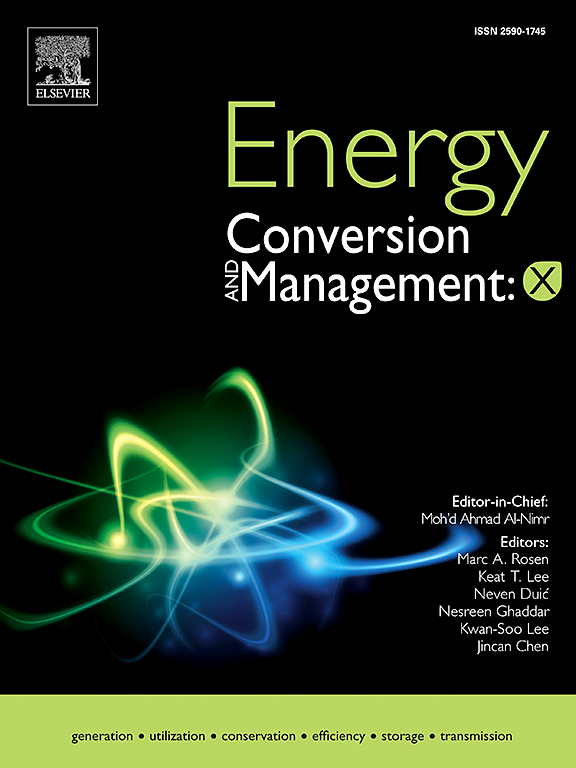从油棕废料中生产绿色氢:技术经济和环境的角度
IF 10.9
1区 工程技术
Q1 ENERGY & FUELS
引用次数: 0
摘要
作为全球第二大棕榈油生产国,马来西亚的棕榈油工业产生了大量的油棕废物。这些废物会排放有害气体,导致环境问题。为了重新利用丰富的棕榈油废物,本研究旨在通过实验和模拟研究进行初步的技术经济和环境分析,以比较氢气的生产。研究了四种不同类型的油棕废弃物,即油棕叶、空果束、油棕树干和棕榈仁壳。为了确定这些原料的近似和最终组成,进行了内部实验工作,然后将这些数据输入到Aspen Plus中进行模拟、技术经济和环境分析。总体而言,这四种情况都可以在19年内收回总资金成本,其中油棕树干原料最为优越。研究发现,油棕树干产氢量最高,为118.65 kg h−1,具有较好的经济效益(最低投资回收期为10.78年,最高净现值为831万美元)。在环境影响方面,油棕树干的使用对全球变暖潜势的贡献最低,为1.95 kg CO2-eq kg−1 H2。这证明了利用生物质气化过程产生的废气为上游需求发电的环境效益。相反,空果束的情况导致了最不令人满意的经济和环境绩效。总的来说,这项工作提供了利用各种油棕废物通过气化制氢的经济可行性和环境影响的见解,以解决未充分利用的油棕废物造成的环境问题。本文章由计算机程序翻译,如有差异,请以英文原文为准。
Green hydrogen production from oil palm wastes: A techno-economic and environmental perspective
As the second-largest producer of palm oil globally, the palm oil industry in Malaysia generates substantial amount of oil palm wastes. These wastes can emit harmful gases and lead to environmental issues. To repurpose the abundantly available palm oil wastes, this study aims to conduct a preliminary techno-economic and environmental analysis via both experimental and simulation study to compare hydrogen production. Four different types of oil palm wastes using biomass gasification are investigated, i.e., oil palm fronds, empty fruit bunches, oil palm trunks, and palm kernel shells. In-house experimental work was conducted to determine the proximate and ultimate composition of these feedstocks, and these data are subsequently input into Aspen Plus for simulation, techno-economic, and environmental analysis. Overall, all four cases can recover the total capital cost within 19 years, with oil palm trunk feedstock being the most superior. It was found that oil palm trunks resulted in the highest hydrogen yield of 118.65 kg h−1 and possessed superior economic performance (i.e., lowest payback period of 10.78 years and highest net present value of 8.31 million USD). In terms of the environmental impact, the use of oil palm trunks contributed to the lowest global warming potential of 1.95 kg CO2-eq kg−1 H2. This demonstrated the environmental benefit of using the waste gas from the biomass gasification process to generate electricity for the upstream demand. On the contrary, the empty fruit bunches case resulted in the least satisfactory economic and environmental performance. Overall, this work provides insights into the economic feasibility and environmental impacts of using various oil palm wastes for hydrogen production through gasification to address the environmental issues caused by the underutilized oil palm wastes.
求助全文
通过发布文献求助,成功后即可免费获取论文全文。
去求助
来源期刊

Energy Conversion and Management
工程技术-力学
CiteScore
19.00
自引率
11.50%
发文量
1304
审稿时长
17 days
期刊介绍:
The journal Energy Conversion and Management provides a forum for publishing original contributions and comprehensive technical review articles of interdisciplinary and original research on all important energy topics.
The topics considered include energy generation, utilization, conversion, storage, transmission, conservation, management and sustainability. These topics typically involve various types of energy such as mechanical, thermal, nuclear, chemical, electromagnetic, magnetic and electric. These energy types cover all known energy resources, including renewable resources (e.g., solar, bio, hydro, wind, geothermal and ocean energy), fossil fuels and nuclear resources.
 求助内容:
求助内容: 应助结果提醒方式:
应助结果提醒方式:


